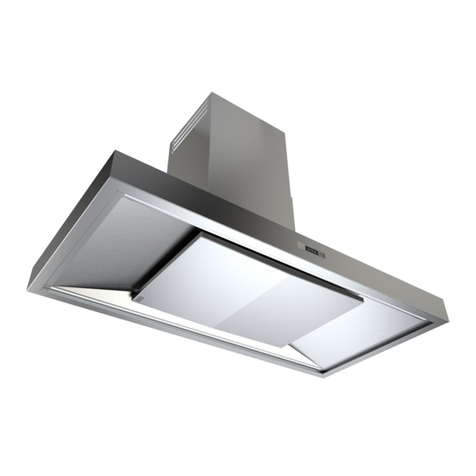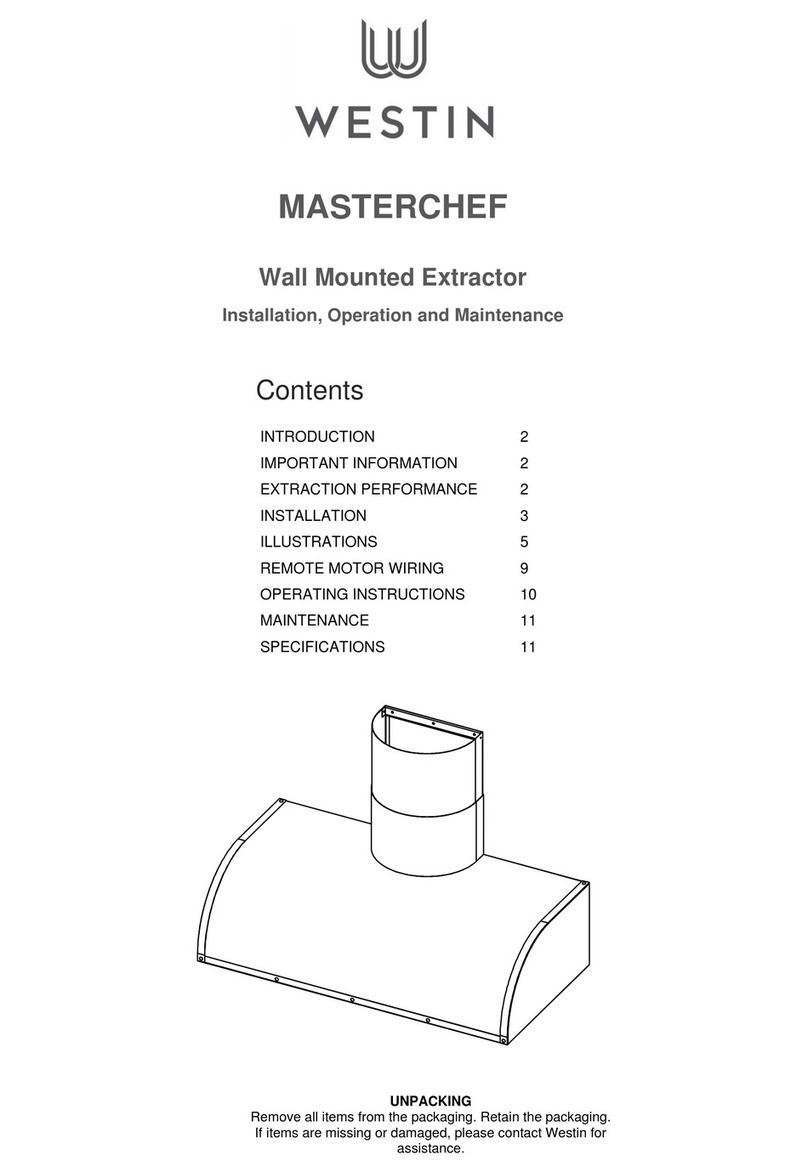W1823 WSW PRIME EDGE 800 -1100 O&M (Energy Label Version) V1 20200608.docxPage 2
1. INTRODUCTION
During the cooking process, there will be heat, vapours and fumes
produced. Your Westin built-in extractor has been designed to
complement your kitchen both inlooks and performancein order to
create a good environment for creative cooking and is ideal for
applications where a conventional cooker hood is neither suitable
nor desirable (in an inglenook chimney or kitchen furniture above
the hob for example).
2. IMPORTANT INFORMATION
The exhaust air must not be discharged into a flue which is used
for exhausting fumes from non-electric appliances such as oil or
gas-fired central heating boilers or gas-fired water heaters, etc.
Requirements of the relevant authorities concerning the discharge
of exhaust air must be complied with.
Pay particular attention to fire risk when frying. To minimise the risk
of fire, all instructions relating to cleaning the grease filters and
removing grease deposits must be adhered to.
Do not flambé under the extractor.
The clearance between the hob burners and the bottom
surface of the cooker hood (extractor) should be within the
following range, unless a greater distance is specified by the
cooking appliance manufacturer:
Hob to underside of the cooker hood clearance distances:
•550mm Minimum above electric hobs (650mm recommended).
•760mm Minimum above all gas hobs and gas or electric wok
burners, griddles, fryers, open grills / barbeques.
•800mm is the maximum recommended distance between the
hob and underside of the cooker hood.
The minimum distance between the hob and the bottom of the
extractor is essential for safety reasons and to prevent overheating
of the extractor and its components.
Exceeding the maximum clearance distance will reduce how
efficiently the cooker hood removes cooking fumes and odours.
Please also note that a 90obend in 150mm flexible ducting will
require 215mm minimum headroom to give a smooth radius with
no kinking.
You are advised to install measures designed to reduce the
incidence of cold draughts entering the property via any
ductwork.
For extractors with internal or inline motors, this should, at the
very least, consist of an external duct termination with
integrated non-return flaps (e.g. gravity shutter wall
grille/louvre) and/or an inline backdraught shutter.
For wall-mounted motors, an inline backdraught shutter is
recommended.
3. EXTRACTION PERFORMANCE
The primary influence on the overall performance of the
extractor is the design of the ducting which takes the exhaust
air from the extractor to the outside. The duct route should be a
prime consideration during the initial stages of the kitchen
design (Westin do not recommend recirculating air backinto the
kitchen).
Please note the following:
•Easy access to the duct route during installation is
important. Lack of access may require the “blind” fitting of
flexible ducting, with increased risk of unseen kinks and
impaired efficiency.
•The extractor is provided with a spigot suitable for
connecting 150mm diameter ducting. The cross-sectional
area of 150mm diameter ducting is the minimum area
consistent with efficient extraction. Reducing the duct size
seriously reduces performance.
•The most efficient configuration is to duct straight through
an outside wall so try to position the cooker against an
outside wall when designing your kitchen.
•Well installed, correctly sized rigid round ducting (or an
equivalent flat channel system) will usually perform best,
with round semi-rigid ducting as an alternative. Flexible (foil
or plastic film) ducting is economical but its use should be
minimised as it gives the worst performance andshould only
be used for very short duct runs or initial connection and
should be pulled taut to prevent significant losses in
extraction efficiency.
•For maximum efficiency, ducting should be kept as short
and as straight as possible. Bends in the duct will degrade
performance so the number of bends in a duct run should
be keptto a minimumand be gradual and smooth toprevent
turbulence. Avoid kinks in flexible ducting and pull the
ducting taut over straight runs to ensure that the internal
surface is as smooth as possible.
•If using rigid ducting, we recommend that the initial duct
connection to the extractor spigot is made using semi-rigid
round ducting to allow for any positioning errors and easy
disconnection in the event of maintenance.
•Ducting and associated components (including complete
kits) are available from Westin.
4. INSTALLATION




































